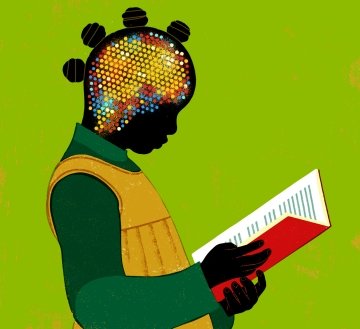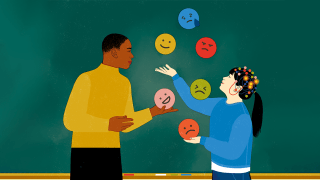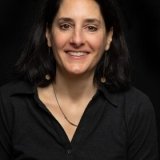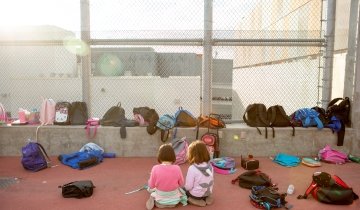The field of Social-Emotional Learning (SEL) is at a moment where it is both lauded and scrutinized in schools. SEL, simply put, involves developing self-awareness, self-control and interpersonal skills within school curricula. The benefits of SEL include an increase in student emotional regulation and empathy, and the ability to make better decisions, which, in turn, can lead to improved test scores, grades and school attendance; increased postsecondary education readiness; and better mental health. With schools grappling with learning loss (p. 27) and an increase in student mental health issues caused by the COVID-19 pandemic, spending on SEL grew roughly 45% between November 2019 and April 2021, according to a report by Tyton Partners, an education consulting and investment firm.
There has, however, been a backlash against teaching these skills. Some critics say social-emotional learning is not meant to be taught by teachers but is better left to parents. Others have gone further, decrying SEL as a covert means to teach public schoolchildren progressive perspectives on race, gender and sexuality, leading some districts to eliminate SEL from their curriculum entirely.
In all of it, the science of social-emotional learning is still emerging, and that’s one of the goals of the USC Center for Affective Neuroscience, Development, Learning and Education (CANDLE), a USC Rossier research center founded and directed by Professor of Education, Psychology & Neuroscience Mary Helen Immordino-Yang.
Immordino-Yang didn’t like school as a kid. She was always interested in the natural world—trying to understand nature and humans’ role in it—but never felt as if she fit in at school. Immordino-Yang studied developmental psychology, lived in various countries after her undergraduate studies, and worked with her hands building boats. Then she injured her hand and found work as a science teacher in a struggling district south of Boston.
It was there, in a classroom of refugee students from all over the world, that she realized how fascinating the problem of education is. “It was the area that I really had always been looking for,” Immordino-Yang says. “It was a problem that was about developmental psychology and the development of mind, but it was also deeply cultural and social, with real-world complexities and implications, unlike what I was seeing in the developmental psychology lab.”
Immordino-Yang, the Fahmy and Donna Attallah Chair in Humanistic Psychology at USC Rossier, has found a way to funnel her varied background into a unique and emerging field. CANDLE, founded in 2020, integrates research on neuroscience, education and psychology to create a new understanding of development and teaching.
What schools get wrong about social-emotional learning
CANDLE’s work often focuses on social-emotional learning, which can be a problematic concept, Immordino-Yang says. It suggests that some kinds of learning are social-emotional, and then the rest of learning is just regular cognitive stuff—which isn’t the case. Succeeding in a math class, for example, takes perseverance, risk-taking, relationship-building and attitude. “We are always deeply social and emotional in everything we think about. We think because we want to; we think because it matters,” she says. “Those are emotional drives.”
Immordino-Yang also says there is a lot of thought about developmental appropriateness in preschools and elementary schools, but little thought about it in middle and high schools. Schools “are deeply inappropriate in the way [they] design around kids’ biological and psychosocial needs for growth,” she says. That’s the other reason she studies adolescents: “because I really want to understand how we [can] meaningfully innovate in the secondary education space.”

The center works to connect brain science to classroom science, by using developmental affective neuroscience to guide the transformation of schools, policy, and the student and teacher experience, with a focus on middle and high school students. Around 10 researchers at CANDLE conduct transdisciplinary studies on teachers and students—for example, scanning teachers’ brains as they graded student work in an MRI machine to show that teachers who think about their role more complexly may have a more consistent pattern of engaging with their students’ work.
They are also working on longitudinal studies of brain development on inner-city, low-socio-economic-status youth from immigrant families throughout Los Angeles County, Immordino-Yang says. The team has conducted extensive qualitative interviews with the kids over several years, and, via the MRI scanner, they have looked at their brain development and functioning as the youth are making sense of complex social stories in real time. The results show that beyond IQ , socioeconomic status or their parents’ education level, brain development can be predicted by the way kids engage with narratives about who they are, Immordino-Yang says. “It’s a really powerful statement about the power young people hold through their own thoughts and feelings to grow themselves over time.”
Another project, being worked on with University of Michigan Professor Jamaal Matthews, is trying to understand how a young person’s processes of creating meaning become the substrate for their biological growth. Matthews received a three-year NSF midcareer faculty fellowship with Immordino-Yang to study social affective neuroscience and collaborate with CANDLE researchers to forge a new conversation and research approach that brings together racial equity studies with developmental brain studies in adolescents.
“We’re trying to understand the sort of psycho-biological, psycho-social, cultural, biological nature of adolescence,” Immordino-Yang says. “It’s really about changing the way we think of teaching as a profession in secondary school: What is the role of the teacher in kids’ lives? What do teachers need to know how to do, [and] what capacities do they need to have to be effective in these spaces?”
The work is part of a scholarly body that could upend traditional ideas about teaching and learning. One of CANDLE’s current challenges is that society has deeply held assumptions about what learning is about, what school is for and what it means to think, Immordino-Yang says. And those assumptions are problematic in many ways. “The thinking and focused attention and quote-unquote academic learning is directly tied to the way that students are feeling, and that’s directly tied to the ways that their social world is structured,” she says.
“We are always deeply social and emotional in everything we think about. We think because we want to; we think because it matters. Those are emotional drives.” —Mary Helen Immordino-Yang, Fahmy and Donna Attallah Chair in Humanistic Psychology at USC Rossier
Research in action
Immordino-Yang’s research can be seen in action at local schools she has partnered with. Da Vinci RISE High in South L.A. is an independent studies high school that serves predominantly foster and housing-unstable youth, says Erin Whalen, the school’s executive director. “We were built and designed for the youth in those populations: If we create a school model with the most at-risk students in mind, that will serve all students really well,” he says.
Whalen says Immordino Yang’s work has been incredible because as a school serving at-risk students, many metrics and measures are rooted in the manifestations of trauma, but at RISE, they start at the most basic of a person’s needs: They have mental health services, family counseling and behavior interventionists all in-house at the school. The school doesn’t suspend or expel students. Whalen says the school uses Immordino-Yang’s work as a basis to place social-emotional learning at the core of the school experience. “Mary Helen has been an incredible thought partner,” Whalen says. “She’s one of our first folks in the mental health-psychology realm to validate the work we’re doing.”
He points out that skills like self-regulation and agency aren’t separate from academic skills: “Social agency and self-management exist in the history classroom, on the playground and in math class.” Those skills are also what employers are looking for—while rote facts can be Googled, social-emotional skills require students to know themselves in a deeper way.
At New Village Girls Academy in Los Angeles, principal Jennifer Quinones started working with Immordino-Yang two years ago, to see how to best support teachers. The school focuses on students who are not successful in traditional settings. They might be young mothers, students who have been bullied or those with other high needs. “You can imagine the amount of social-emotional learning trauma they bring to school with them,” says Quinones. “One thing that has been ignored is that the trauma is also carried by the adults working with them.”
Immordino-Yang is leading a team of researchers to figure out how to help teachers manage their stress—to “put on their own oxygen masks first,” Quinones says. She worked at another school where she noticed a correlation between teachers who were angry and frustrated and the likelihood that their students would violate probation terms and end up back in juvenile hall. By being proactive about wellness and stress reduction, she says, her school has retained more teachers, and they are doing better than before. “If we’re not making sure the adults molding them are OK, then we are failing completely,” she says. “If we wanted to promote the practice of wellness, we also needed to be the example for our girls.”
The study has concluded, and researchers from CANDLE are putting together the data with the hope of doing a follow-up in the future. “Mary Helen is very special in what she can do,” Quinones says. “She brought edu-babble to a level that everyone can understand. She talks about how the brain functions, what stress causes, and the damaging effects it can have on the development of a child.”
“She brought a real wealth of knowledge of the actual scientific evidence, thinking about how to incorporate wellness into math, science and history,” Quinones adds. Immordino-Yang is also helping the school think about how to teach courses that are culturally responsive and how to help teachers have mechanisms to help students develop self-awareness to be able to better communicate.
“Mary Helen Immordino-Yang brought edu-babble to a level that everyone can understand. She talks about how the brain functions, what stress causes and the damaging effects it can have on the development of a child.” —Jennifer Quinones, principal at New Village Girls Academy
It’s not always easy work. Immordino-Yang says developing a new knowledge of education and neurodevelopment is messy, generative and not always efficient. She is publishing papers in neuroscience journals, but also journals of education, philosophy and political science.
Still, she hopes CANDLE’s work will contribute to a more inclusive educational world, one that focuses on process instead of outcome in development and learning. The rise of social-emotional learning curricula around the country has been heralded as a tool to promote equity in learning. She thinks that in the future, teachers and students will start to appreciate the deeply cultural nature of human biology and understand more diverse perspectives around science learning and teaching—based on development. “We’re really inventing a new transdisciplinary approach to developmental science,” she says, “with the goal of creating a richer, more modernized understanding of human development.”





